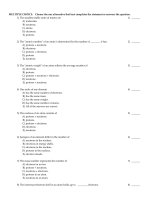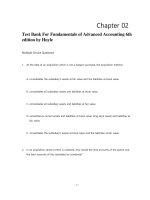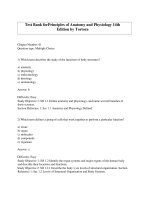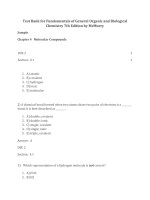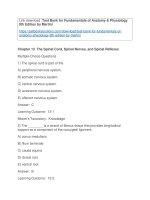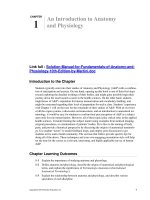Test bank for fundamentals of anatomy and physiology 11e c05
Bạn đang xem bản rút gọn của tài liệu. Xem và tải ngay bản đầy đủ của tài liệu tại đây (674.51 KB, 27 trang )
Chapterȱ5
TheȱIntegumentaryȱSystem
Multiple Choice Questions
1) Accumulationsȱofȱfluidȱwithinȱtheȱepidermisȱorȱbetweenȱtheȱepidermisȱandȱtheȱdermisȱis/are
called
A) keloids.
B) scabs.
C) blisters.
D) scars.
E) pus.
Answer: C
LearningȱOutcome: 5-1
BloomȇsȱTaxonomy: Understanding
2) Rapidȱwaterȱlossȱfromȱburnedȱskinȱisȱanȱextremeȱformȱofȱ________ȱperspiration.
A) imprudent
B) non-sense
C) impractical
D) vacuous
E) insensible
Answer: E
LearningȱOutcome: 5-1
BloomȇsȱTaxonomy: Understanding
3) Eachȱofȱtheȱfollowingȱisȱaȱfunctionȱofȱtheȱintegumentaryȱsystemȱ except
A) protectionȱofȱunderlyingȱtissue.
B) excretionȱofȱsaltsȱandȱwastes.
C) maintenanceȱofȱbodyȱtemperature.
D) synthesisȱofȱvitaminȱC.
E) detectionȱofȱsensations.
Answer: D
LearningȱOutcome: 5-1
BloomȇsȱTaxonomy: Understanding
4) Theȱtwoȱcomponentsȱofȱtheȱintegumentaryȱsystemȱareȱthe
A) epidermisȱandȱdermis.
B) cutaneousȱmembraneȱandȱhypodermis.
C) cutaneousȱmembraneȱandȱaccessoryȱstructures.
D) integumentȱandȱhypodermis.
E) epidermisȱandȱsuperficialȱfascia.
Answer: C
LearningȱOutcome: 5-1
BloomȇsȱTaxonomy: Remembering
Copyrightȱ©ȱ2018ȱPearsonȱEducation,ȱInc.
138ȱȱȱTestȱBankȱforȱFundamentalsȱofȱAnatomyȱ&ȱPhysiology,ȱ11e
5) Theȱtypeȱofȱcellsȱthatȱformȱtheȱstrataȱinȱtheȱepidermisȱare
A) adipocytes.
B) keratinocytes.
C) fibroblasts.
D) melanocytes.
E) dendriticȱcells.
Answer: B
LearningȱOutcome: 5-1
BloomȇsȱTaxonomy: Remembering
6) Theȱtoughȱsuperficialȱlayerȱofȱtheȱepidermisȱisȱknownȱasȱtheȱstratum
A) corneum.
B) lucidum.
C) basale.
D) granulosum.
E) spinosum.
Answer: A
LearningȱOutcome: 5-1
BloomȇsȱTaxonomy: Remembering
7) Theȱlargestȱquantitiesȱofȱkeratinȱareȱfoundȱinȱtheȱepidermalȱlayerȱcalledȱtheȱstratum
A) corneum.
B) lucidum.
C) basale.
D) granulosum.
E) spinosum.
Answer: A
LearningȱOutcome: 5-1
BloomȇsȱTaxonomy: Understanding
8) Waterȱlossȱdueȱtoȱevaporationȱofȱfluidȱthatȱhasȱpenetratedȱthroughȱtheȱskinȱisȱcalledȱ________
perspiration.
A) sensible
B) insensible
C) latent
D) active
E) inactive
Answer: B
LearningȱOutcome: 5-1
BloomȇsȱTaxonomy: Remembering
Copyrightȱ©ȱ2018ȱPearsonȱEducation,ȱInc.
Chapterȱ5ȱȱTheȱIntegumentaryȱSystemȱȱȱ139
9) Theȱlayerȱofȱtheȱepidermisȱthatȱcontainsȱseveralȱlayersȱofȱlivingȱcellsȱconnectedȱbyȱabundant
desmosomesȱisȱtheȱstratum
A) corneum.
B) lucidum.
C) basale.
D) granulosum.
E) spinosum.
Answer: E
LearningȱOutcome: 5-1
BloomȇsȱTaxonomy: Understanding
10) Theȱlayerȱofȱtheȱskinȱthatȱprovidesȱaȱbarrierȱagainstȱbacteriaȱasȱwellȱasȱchemicalȱand
mechanicalȱinjuriesȱisȱthe
A) dermis.
B) subcutaneousȱlayer.
C) epidermis.
D) stratumȱbasale.
E) sebaceousȱlayer.
Answer: C
LearningȱOutcome: 5-1
BloomȇsȱTaxonomy: Remembering
11) Characteristicsȱofȱtheȱepidermisȱinclude
A) multilayered.
B) flexible.
C) containsȱdesmosomes.
D) servesȱasȱUVȱradiationȱprotection.
E) Allȱofȱtheȱanswersȱareȱcorrect.
Answer: E
LearningȱOutcome: 5-1
BloomȇsȱTaxonomy: Understanding
12) Allȱofȱtheȱfollowingȱareȱtrueȱofȱepidermalȱridgesȱexcept thatȱthey
A) extendȱintoȱtheȱhypodermis.
B) increaseȱsurfaceȱareaȱandȱfrictionȱonȱfingertips.
C) causeȱridgeȱpatternsȱonȱtheȱsurfaceȱofȱtheȱskin.
D) produceȱpatternsȱthatȱareȱdeterminedȱpartiallyȱgenetically.
E) interconnectȱwithȱtheȱdermalȱpapillae.
Answer: A
LearningȱOutcome: 5-1
BloomȇsȱTaxonomy: Understanding
Copyrightȱ©ȱ2018ȱPearsonȱEducation,ȱInc.
140ȱȱȱTestȱBankȱforȱFundamentalsȱofȱAnatomyȱ&ȱPhysiology,ȱ11e
13) ________ȱareȱcellsȱinȱtheȱepidermisȱthatȱareȱpartȱofȱtheȱimmuneȱsystem.
A) Dendriticȱcells
B) Basalȱcells
C) Merkelȱcells
D) Squamousȱcells
E) Melanocytes
Answer: A
LearningȱOutcome: 5-1
BloomȇsȱTaxonomy: Remembering
14) Waterȱlossȱfromȱinsensibleȱperspiration
A) isȱunaffectedȱbyȱdamageȱtoȱtheȱepidermis.
B) isȱtooȱsmallȱtoȱbeȱmeasuredȱreliably.
C) isȱapproximatelyȱ0.5ȱlitersȱaȱday.
D) alwaysȱexceedsȱsensibleȱperspiration.
E) dependsȱonȱapocrineȱsweatȱglands.
Answer: C
LearningȱOutcome: 5-1
BloomȇsȱTaxonomy: Understanding
15) Theȱepidermisȱofȱtheȱskinȱisȱcomposedȱofȱwhatȱtypeȱofȱtissue?
A) keratinizedȱstratifiedȱsquamousȱepithelium
B) simpleȱsquamousȱepithelium
C) transitionalȱepithelium
D) areolarȱconnectiveȱtissue
E) nonkeratinizedȱstratifiedȱsquamousȱepithelium
Answer: A
LearningȱOutcome: 5-1
BloomȇsȱTaxonomy: Remembering
16) Theȱlayerȱofȱstemȱcellsȱthatȱconstantlyȱdivideȱtoȱrenewȱtheȱepidermisȱisȱthe
A) stratumȱcorneum.
B) stratumȱbasale.
C) papillaryȱlayer.
D) basalȱlamina.
E) stratumȱgranulosum.
Answer: B
LearningȱOutcome: 5-1
BloomȇsȱTaxonomy: Remembering
17) Theȱproteinȱthatȱreducesȱwaterȱlossȱatȱtheȱskinȱsurfaceȱis
A) eleidin.
B) collagen.
C) mucin.
D) keratin.
E) melanin.
Answer: D
LearningȱOutcome: 5-1
BloomȇsȱTaxonomy: Remembering
Copyrightȱ©ȱ2018ȱPearsonȱEducation,ȱInc.
Chapterȱ5ȱȱTheȱIntegumentaryȱSystemȱȱȱ141
18) Thinȱskinȱcontainsȱ________ȱepidermalȱlayer(s)ȱandȱthickȱskinȱcontainsȱ________ȱlayers.
A) 1;ȱ2
B) 2;ȱ3
C) 3;ȱ4
D) 4;ȱ5
E) 5;ȱ6
Answer: D
LearningȱOutcome: 5-1
BloomȇsȱTaxonomy: Understanding
19) Whileȱwalkingȱbarefootȱonȱtheȱbeach,ȱJoeȱsteppedȱonȱaȱthornȱthatȱpenetratedȱthroughȱtheȱsole
ofȱhisȱfootȱtoȱtheȱdermis.ȱHowȱmanyȱlayersȱofȱepidermisȱdidȱtheȱthornȱpenetrate?
A) 1
B) 2
C) 3
D) 4
E) 5
Answer: E
LearningȱOutcome: 5-1
BloomȇsȱTaxonomy: Applying
20) Whichȱofȱfollowingȱisȱnotȱanȱaccessoryȱstructureȱofȱtheȱintegumentaryȱsystem?
A) sweatȱglands
B) hairȱfollicles
C) exocrineȱglands
D) nails
E) dermis
Answer: E
LearningȱOutcome: 5-1
BloomȇsȱTaxonomy: Remembering
21) Allȱofȱtheȱfollowingȱcontainȱbloodȱvesselsȱexcept the
A) epidermis.
B) papillaryȱlayer.
C) reticularȱlayer.
D) subcutaneousȱlayer.
E) hypodermis.
Answer: A
LearningȱOutcome: 5-1
BloomȇsȱTaxonomy: Understanding
22) Theȱsensoryȱcellsȱassociatedȱwithȱtheȱdeepȱlayersȱofȱtheȱepidermisȱare
A) Pacinianȱcorpuscles.
B) Merkelȱcells.
C) melanocytes.
D) Meissnerȇsȱcorpuscles.
E) keratinocytes.
Answer: B
LearningȱOutcome: 5-1
BloomȇsȱTaxonomy: Remembering
Copyrightȱ©ȱ2018ȱPearsonȱEducation,ȱInc.
142ȱȱȱTestȱBankȱforȱFundamentalsȱofȱAnatomyȱ&ȱPhysiology,ȱ11e
23) Theȱlayerȱofȱepidermisȱwhereȱmostȱcellsȱhaveȱstoppedȱdividingȱandȱstartedȱmakingȱlarge
amountsȱofȱkeratinȱisȱthe
A) stratumȱspinosum.
B) stratumȱcorneum.
C) stratumȱgranulosum.
D) stratumȱlucidum.
E) stratumȱbasale.
Answer: C
LearningȱOutcome: 5-1
BloomȇsȱTaxonomy: Remembering
24) Theȱlayerȱofȱepidermisȱwhereȱkeratohyalinȱcrosslinksȱkeratinȱfibersȱisȱthe
A) stratumȱspinosum.
B) stratumȱcorneum.
C) stratumȱgranulosum.
D) stratumȱlucidum.
E) stratumȱbasale.
Answer: C
LearningȱOutcome: 5-1
BloomȇsȱTaxonomy: Remembering
25) Theȱamountȱofȱtimeȱitȱtakesȱforȱaȱcellȱtoȱprogressȱfromȱstratumȱbasaleȱtoȱstratumȱcorneumȱis
A) 7-10ȱdays.
B) 14ȱdays.
C) 5ȱdays.
D) 1ȱday.
E) 1ȱminute.
Answer: A
LearningȱOutcome: 5-1
BloomȇsȱTaxonomy: Remembering
Copyrightȱ©ȱ2018ȱPearsonȱEducation,ȱInc.
Chapterȱ5ȱȱTheȱIntegumentaryȱSystemȱȱȱ143
Figureȱ5-1ȱȱTheȱComponentsȱofȱtheȱIntegumentaryȱSystem
UseȱFigureȱ5-1ȱtoȱanswerȱtheȱfollowingȱquestions:
26) Fromȱwhatȱstructureȱdoesȱsensibleȱperspirationȱoccur?
A) 6
B) 7
C) 8
D) 9
E) 10
Answer: E
LearningȱOutcome: 5-1
BloomȇsȱTaxonomy: Applying
Copyrightȱ©ȱ2018ȱPearsonȱEducation,ȱInc.
144ȱȱȱTestȱBankȱforȱFundamentalsȱofȱAnatomyȱ&ȱPhysiology,ȱ11e
27) Whichȱlayerȱisȱtheȱprimaryȱbarrierȱagainstȱenvironmentalȱhazards?
A) 1
B) 2
C) 3
D) 4
E) 5
Answer: A
LearningȱOutcome: 5-1
BloomȇsȱTaxonomy: Applying
28) Whichȱlayerȱcontainsȱmostȱofȱtheȱaccessoryȱstructures?
A) 1
B) 2
C) 3
D) 4
E) 5
Answer: C
LearningȱOutcome: 5-1
BloomȇsȱTaxonomy: Applying
29) Adiposeȱtissueȱisȱaȱmajorȱcomponentȱofȱtheȱregionȱlabeled
A) 1.
B) 2.
C) 3.
D) 4.
E) 5.
Answer: E
LearningȱOutcome: 5-2
BloomȇsȱTaxonomy: Applying
30) WhichȱtissueȱisȱlocatedȱinȱtheȱregionȱlabeledȱȈ2Ȉ?
A) stratifiedȱsquamousȱepithelium
B) areolarȱconnectiveȱtissue
C) adiposeȱtissue
D) cartilageȱandȱblood
E) reticularȱconnectiveȱtissues
Answer: B
LearningȱOutcome: 5-2
BloomȇsȱTaxonomy: Applying
31) Theȱlayerȱofȱtheȱskinȱthatȱcontainsȱbundlesȱofȱcollagenȱandȱelasticȱfibersȱresponsibleȱforȱthe
strengthȱofȱtheȱskinȱisȱtheȱ________ȱlayer.
A) papillary
B) reticular
C) epidermal
D) subcutaneous
E) hypodermal
Answer: B
LearningȱOutcome: 5-2
BloomȇsȱTaxonomy: Remembering
Copyrightȱ©ȱ2018ȱPearsonȱEducation,ȱInc.
Chapterȱ5ȱȱTheȱIntegumentaryȱSystemȱȱȱ145
32) Theȱdrugȱtretinoinȱ(Retin-A)
A) reducesȱtheȱappearanceȱofȱfineȱwrinkles.
B) minimizesȱscarringȱafterȱsurgery.
C) stimulatesȱhairȱgrowth.
D) improvesȱnightȱvision.
E) isȱusedȱtoȱtreatȱdandruff.
Answer: A
LearningȱOutcome: 5-2
BloomȇsȱTaxonomy: Understanding
33) Skinȱinflammationȱthatȱprimarilyȱinvolvesȱtheȱpapillaryȱlayerȱisȱtermed
A) papillitis.
B) dermatitis.
C) epidermatitis.
D) superficialis.
E) melanocytis.
Answer: B
LearningȱOutcome: 5-2
BloomȇsȱTaxonomy: Remembering
34) Aȱsurgicalȱincisionȱparallelȱtoȱtheȱlinesȱofȱcleavage
A) closesȱandȱhealsȱwithȱrelativelyȱlittleȱscarring.
B) hasȱaȱtendencyȱtoȱreopen.
C) healsȱslowerȱthanȱincisionsȱmadeȱperpendicularȱtoȱtheȱlinesȱofȱcleavage.
D) doesȱnotȱaffectȱtheȱhealingȱprocess.
E) requiresȱnoȱsutures.
Answer: A
LearningȱOutcome: 5-2
BloomȇsȱTaxonomy: Understanding
35) Whileȱassessingȱaȱpatient,ȱyouȱdiscoverȱthatȱafterȱpinchingȱtheȱskinȱonȱtheȱbackȱofȱtheȱhand,ȱit
remainsȱpeaked.ȱThisȱisȱaȱsignȱof
A) hydrationȱintoxication.
B) waterȱintoxication.
C) dehydration.
D) advancedȱskinȱcancer.
E) malfunctioningȱelastin.
Answer: C
LearningȱOutcome: 5-2
BloomȇsȱTaxonomy: Analyzing
36) Stretchȱmarksȱoccurȱwhen
A) theȱskinȱisȱstretchedȱinȱnormalȱmovements.
B) surgicalȱincisionsȱareȱmadeȱperpendicularȱtoȱtheȱskinȇsȱlinesȱofȱcleavage.
C) theȱskinȱisȱsoȱextensivelyȱstretchedȱthatȱitsȱelasticȱlimitsȱareȱexceeded.
D) athletesȱoverextendȱaȱmuscle.
E) individualȱepidermalȱlayersȱseparate.
Answer: C
LearningȱOutcome: 5-2
BloomȇsȱTaxonomy: Understanding
Copyrightȱ©ȱ2018ȱPearsonȱEducation,ȱInc.
146ȱȱȱTestȱBankȱforȱFundamentalsȱofȱAnatomyȱ&ȱPhysiology,ȱ11e
37) Theȱcutaneousȱplexusȱis
A) aȱnetworkȱofȱnervesȱinȱtheȱcutaneousȱmembrane.
B) aȱsuperficialȱnetworkȱofȱdermalȱarteries.
C) aȱdeepȱnetworkȱofȱdermalȱarteriesȱalongȱtheȱboundaryȱofȱtheȱreticularȱlayer.
D) aȱneuralȱplexusȱresponsibleȱforȱdeepȱpressure.
E) aȱnetworkȱofȱarteriesȱinȱtheȱepidermis.
Answer: C
LearningȱOutcome: 5-2
BloomȇsȱTaxonomy: Understanding
38) Theȱsubpapillaryȱplexusȱis
A) aȱnetworkȱofȱnervesȱinȱtheȱcutaneousȱmembrane.
B) aȱsuperficialȱnetworkȱofȱdermalȱarteries.
C) aȱdeepȱnetworkȱofȱdermalȱarteriesȱalongȱtheȱboundaryȱofȱtheȱreticularȱlayer.
D) aȱneuralȱplexusȱresponsibleȱforȱdeepȱpressure.
E) aȱnetworkȱofȱarteriesȱinȱtheȱepidermis.
Answer: B
LearningȱOutcome: 5-2
BloomȇsȱTaxonomy: Understanding
39) Whatȱareȱtheȱdermalȱsensoryȱstructuresȱthatȱsenseȱdeepȱpressure?
A) Meissnerȇsȱcorpuscles
B) lamellarȱcorpuscle
C) tactileȱcorpuscles
D) tactileȱdics
E) Merkelȱcells
Answer: B
LearningȱOutcome: 5-2
BloomȇsȱTaxonomy: Remembering
40) Allȱofȱtheȱfollowingȱareȱtrueȱofȱtheȱsubcutaneousȱlayerȱexcept it
A) containsȱmanyȱbloodȱvessels.
B) permitsȱindependentȱmovementȱofȱdeeperȱstructures.
C) containsȱlargeȱamountsȱofȱadiposeȱtissue.
D) isȱattachedȱtoȱtheȱdermisȱbyȱaȱbasementȱmembrane.
E) isȱwellȱsuppliedȱwithȱnervesȱthatȱpassȱintoȱtheȱskin.
Answer: D
LearningȱOutcome: 5-3
BloomȇsȱTaxonomy: Understanding
41) Theȱlayerȱofȱlooseȱconnectiveȱtissueȱdeepȱtoȱtheȱdermisȱisȱthe
A) epidermis.
B) subcutaneousȱlayer.
C) hyperdermis.
D) deepȱfascia.
E) reticularȱlayer.
Answer: B
LearningȱOutcome: 5-3
BloomȇsȱTaxonomy: Remembering
Copyrightȱ©ȱ2018ȱPearsonȱEducation,ȱInc.
Chapterȱ5ȱȱTheȱIntegumentaryȱSystemȱȱȱ147
42) Theȱprimaryȱpigmentsȱcontainedȱinȱtheȱepidermisȱare
A) carotene,ȱhemoglobin,ȱandȱxanthophyll.
B) carotene,ȱeumelanin,ȱandȱpheomelanin.
C) melanin,ȱchromatin,ȱandȱchlorophyll.
D) xanthophyll,ȱhemoglobin,ȱandȱmelanin.
E) melanin,ȱcarotene,ȱandȱchromatin.
Answer: B
LearningȱOutcome: 5-4
BloomȇsȱTaxonomy: Understanding
43) Anȱalbinoȱindividualȱlacksȱtheȱabilityȱtoȱproduce
A) melanin.
B) keratin.
C) carotene.
D) perspiration.
E) eleidin.
Answer: A
LearningȱOutcome: 5-4
BloomȇsȱTaxonomy: Remembering
44) Cyanosisȱsignifiesȱthatȱaȱpatientȱhas
A) hadȱtooȱmuchȱsun.
B) beenȱkeptȱoutȱofȱtheȱsun.
C) anȱallergicȱreaction.
D) oxygen-starvedȱskin.
E) beenȱexposedȱtoȱcyanide.
Answer: D
LearningȱOutcome: 5-4
BloomȇsȱTaxonomy: Understanding
45) Jaundiceȱisȱindicatedȱbyȱa(n)ȱ________ȱskinȱcoloration.
A) reddish
B) yellowish
C) orange
D) bluish
E) brown
Answer: B
LearningȱOutcome: 5-4
BloomȇsȱTaxonomy: Remembering
46) Exposureȱtoȱultravioletȱlightȱ(sunlight)ȱcausesȱtheȱskinȱtoȱdarkenȱbyȱincreasingȱtheȱproduction
of
A) hemoglobin.
B) carotene.
C) collagen.
D) keratin.
E) melanin.
Answer: E
LearningȱOutcome: 5-4
BloomȇsȱTaxonomy: Understanding
Copyrightȱ©ȱ2018ȱPearsonȱEducation,ȱInc.
148ȱȱȱTestȱBankȱforȱFundamentalsȱofȱAnatomyȱ&ȱPhysiology,ȱ11e
47) Theȱ________ȱinȱkeratinocytesȱprotectsȱtheȱepidermisȱandȱdermisȱfromȱtheȱharmfulȱeffectsȱof
sunlight.
A) sebum
B) hemoglobin
C) melanin
D) carotene
E) keratin
Answer: C
LearningȱOutcome: 5-4
BloomȇsȱTaxonomy: Understanding
48) Theȱpigmentȱfoundȱinȱvegetablesȱthatȱcanȱmakeȱtheȱskinȱappearȱorangeȱorȱyellowȱisȱcalled
A) cadmium.
B) carotene.
C) hemoglobin.
D) keratin.
E) melanin.
Answer: B
LearningȱOutcome: 5-4
BloomȇsȱTaxonomy: Remembering
49) Melaninȱisȱproducedȱbyȱmelanocytesȱwithinȱtheȱstratum
A) corneum.
B) lucidum.
C) granulosum.
D) spinosum.
E) basale.
Answer: E
LearningȱOutcome: 5-4
BloomȇsȱTaxonomy: Remembering
50) Whichȱoneȱofȱtheȱfollowingȱisȱtheȱred-yellowȱformȱofȱmelanin?
A) eumelanin
B) phycomelanin
C) anthomelanin
D) pheomelanin
E) promelanin
Answer: D
LearningȱOutcome: 5-4
BloomȇsȱTaxonomy: Remembering
51) Whichȱofȱtheȱfollowingȱisȱtheȱbrown-blackȱformȱofȱmelanin?
A) eumelanin
B) phycomelanin
C) anthomelanin
D) pheomelanin
E) promelanin
Answer: A
LearningȱOutcome: 5-4
BloomȇsȱTaxonomy: Remembering
Copyrightȱ©ȱ2018ȱPearsonȱEducation,ȱInc.
Chapterȱ5ȱȱTheȱIntegumentaryȱSystemȱȱȱ149
52) Whichȱofȱtheȱfollowingȱisȱnotȱtrueȱofȱmelanin?
A) Thereȱisȱmoreȱthanȱ1ȱtypeȱofȱmelanin.
B) Melaninȱisȱreleasedȱbyȱexocytosis.
C) Itȱisȱmanufacturedȱfromȱtyrosine.
D) Itȱisȱpackagedȱinȱvesiclesȱcalledȱmelanosomes.
E) ItȱabsorbsȱUVȱradiation.
Answer: B
LearningȱOutcome: 5-4
BloomȇsȱTaxonomy: Applying
53) Whichȱofȱtheȱfollowingȱcausesȱyellowingȱofȱtheȱskin?
A) vitiligo
B) pituitaryȱtumorȱaffectingȱmelanocyteȱstimulatingȱhormone
C) Addisonȇsȱdisease
D) cyanosis
E) faultyȱbileȱexcretionȱinȱtheȱliver
Answer: E
LearningȱOutcome: 5-4
BloomȇsȱTaxonomy: Understanding
54) Whichȱpigmentȱisȱresponsibleȱforȱblushing?
A) eumelanin
B) pheomelanin
C) carotene
D) hemoglobin
E) melanocyteȱstimulatingȱhormone
Answer: D
LearningȱOutcome: 5-4
BloomȇsȱTaxonomy: Applying
55) Whichȱofȱtheȱfollowingȱisȱnotȱanȱeffectȱofȱultravioletȱradiation?
A) increasedȱactivityȱbyȱmelanocytes
B) productionȱofȱcholecalciferolȱwithinȱepidermalȱcells
C) reducedȱamountsȱofȱelasticȱfibersȱinȱtheȱdermis
D) chromosomalȱdamageȱinȱgerminativeȱcellsȱorȱmelanocytes
E) lossȱinȱskinȱpigmentationȱasȱseenȱinȱvitiligo
Answer: E
LearningȱOutcome: 5-5
BloomȇsȱTaxonomy: Understanding
56) Whichȱofȱtheȱfollowingȱisȱformedȱinȱtheȱskinȱwhenȱitȱisȱexposedȱtoȱsunlight?
A) vitaminȱA
B) vitaminȱB
C) vitaminȱC
D) vitaminȱD
E) vitaminȱE
Answer: D
LearningȱOutcome: 5-5
BloomȇsȱTaxonomy: Understanding
Copyrightȱ©ȱ2018ȱPearsonȱEducation,ȱInc.
150ȱȱȱTestȱBankȱforȱFundamentalsȱofȱAnatomyȱ&ȱPhysiology,ȱ11e
57) Whichȱofȱtheȱfollowingȱstatementsȱaboutȱricketsȱisȱnot true?
A) Itȱisȱusuallyȱgenetic.
B) Itȱleadsȱtoȱweakȱbones.
C) Itȱleadsȱtoȱskeletalȱdeformity.
D) ItȱisȱpreventedȱbyȱvitaminȱD.
E) Itȱisȱpreventedȱbyȱsunlight.
Answer: A
LearningȱOutcome: 5-5
BloomȇsȱTaxonomy: Understanding
58) Aȱdeficiencyȱdiseaseȱthatȱillustratesȱtheȱeffectȱofȱintegumentaryȱsystemȱfunctionȱonȱthe
structureȱofȱtheȱskeletalȱsystemȱis
A) osteoporosis.
B) seborrheicȱdermatitis.
C) decubitusȱulcers.
D) rickets.
E) beriberi.
Answer: D
LearningȱOutcome: 5-5
BloomȇsȱTaxonomy: Understanding
59) Theȱmostȱdangerousȱtypeȱofȱskinȱcancerȱisȱcalled
A) keratosis.
B) psoriasis.
C) squamousȱcellȱcarcinoma.
D) melanoma.
E) basalȱcellȱcarcinoma.
Answer: D
LearningȱOutcome: 5-5
BloomȇsȱTaxonomy: Remembering
60) VitaminȱD3ȱisȱimportantȱforȱproperȱ________ȱdevelopment.
A) skin
B) bone
C) muscle
D) vision
E) neural
Answer: B
LearningȱOutcome: 5-5
BloomȇsȱTaxonomy: Understanding
61) Skinȱcancerȱthatȱstartsȱinȱtheȱmitoticallyȱmostȱactiveȱepidermalȱlayerȱisȱcalled
A) keratosis.
B) psoriasis.
C) squamousȱcellȱcarcinoma.
D) melanoma.
E) basalȱcellȱcarcinoma.
Answer: E
LearningȱOutcome: 5-5
BloomȇsȱTaxonomy: Remembering
Copyrightȱ©ȱ2018ȱPearsonȱEducation,ȱInc.
Chapterȱ5ȱȱTheȱIntegumentaryȱSystemȱȱȱ151
62) Childrenȱinȱnorthernȱregionsȱexperienceȱmonthsȱofȱinadequateȱsunlightȱexposureȱonȱtheȱskin.
Toȱpreventȱpossibleȱabnormalȱboneȱdevelopment,ȱwhatȱessentialȱorganicȱnutrientȱisȱnecessary
inȱtheȱdiet?
A) vitaminȱC
B) calcium
C) cholecalciferol
D) protein
E) retinol-A
Answer: C
LearningȱOutcome: 5-5
BloomȇsȱTaxonomy: Applying
63) Theȱlayerȱofȱhardȱkeratinȱthatȱactsȱasȱtheȱsurfaceȱofȱtheȱhairȱisȱtermedȱthe
A) medulla.
B) cuticle.
C) hairȱbulb.
D) root.
E) shaft.
Answer: B
LearningȱOutcome: 5-6
BloomȇsȱTaxonomy: Remembering
64) Variationsȱinȱhairȱcolorȱreflectȱdifferencesȱinȱtheȱpigmentȱproducedȱby
A) keratinocytes.
B) melanocytes.
C) dermalȱpapillae.
D) softȱkeratin.
E) caroteneȱcells.
Answer: B
LearningȱOutcome: 5-6
BloomȇsȱTaxonomy: Remembering
65) Whichȱofȱtheȱfollowingȱisȱcorrect aboutȱLanugoȱhairs?
A) alsoȱknownȱasȱȈpeachȱfuzzȈ
B) persistsȱthroughoutȱtheȱentireȱlife
C) deeplyȱpigmentedȱandȱsomewhatȱcoarse
D) existsȱprimarilyȱinȱfetuses
E) neverȱfoundȱonȱtheȱfeet
Answer: D
LearningȱOutcome: 5-6
BloomȇsȱTaxonomy: Understanding
Copyrightȱ©ȱ2018ȱPearsonȱEducation,ȱInc.
152ȱȱȱTestȱBankȱforȱFundamentalsȱofȱAnatomyȱ&ȱPhysiology,ȱ11e
66) Ifȱtheȱpapillaȱofȱaȱhairȱfollicleȱisȱdestroyed,
A) theȱhairȱproducedȱbyȱtheȱfollicleȱwillȱchangeȱfromȱterminalȱtoȱvellus.
B) theȱcolorȱofȱtheȱhairȱwillȱbecomeȱlighter.
C) theȱtextureȱofȱtheȱhairȱwillȱbecomeȱcoarser.
D) theȱhairȱmatrixȱwillȱloseȱitsȱbloodȱsupply.
E) hairȱproductionȱwillȱnotȱbeȱaffected.
Answer: D
LearningȱOutcome: 5-6
BloomȇsȱTaxonomy: Understanding
67) Whenȱtheȱarrectorȱpiliȱmusclesȱcontract,
A) ȈgooseȱbumpsȈȱareȱformed.
B) hairsȱareȱshed.
C) sweatȱisȱreleasedȱfromȱsweatȱglands.
D) shiveringȱoccurs.
E) theȱskinȱchangesȱcolor.
Answer: A
LearningȱOutcome: 5-6
BloomȇsȱTaxonomy: Understanding
68) Whichȱofȱtheȱfollowingȱstatementsȱconcerningȱhairȱisȱfalse?
A) Theȱmedullaȱisȱtheȱsoftȱcoreȱofȱtheȱhair.
B) Theȱcortexȱofȱtheȱhairȱisȱcomposedȱofȱhardȱkeratin.
C) Terminalȱhairsȱareȱheavyȱandȱmoreȱdarklyȱpigmentedȱthanȱotherȱtypesȱofȱhair.
D) Clubȱhairȱisȱhairȱthatȱhasȱceasedȱgrowing.
E) Scalpȱhairsȱgrowȱconstantlyȱthroughoutȱlife.
Answer: E
LearningȱOutcome: 5-6
BloomȇsȱTaxonomy: Understanding
69) Fineȱhairsȱ(likeȱȈvelvetȈ)ȱthatȱlackȱpigmentȱandȱcoverȱmuchȱofȱtheȱbodyȱsurfaceȱareȱcalled
________ȱhairs.
A) veneer
B) gossamer
C) lanugo
D) vellus
E) terminal
Answer: D
LearningȱOutcome: 5-6
BloomȇsȱTaxonomy: Remembering
70) Coarseȱpigmentedȱhairsȱareȱcalledȱ________ȱhairs.
A) veneer
B) gossamer
C) lanugo
D) vellus
E) terminal
Answer: E
LearningȱOutcome: 5-6
BloomȇsȱTaxonomy: Remembering
Copyrightȱ©ȱ2018ȱPearsonȱEducation,ȱInc.
Chapterȱ5ȱȱTheȱIntegumentaryȱSystemȱȱȱ153
71) Theȱnetworkȱofȱsensoryȱnervesȱthatȱsurroundsȱtheȱbaseȱofȱeachȱhairȱfollicleȱisȱthe
A) rootȱhairȱplexus.
B) hairȱpapilla.
C) hairȱmatrix.
D) cutaneousȱplexus.
E) subpapillaryȱplexus.
Answer: A
LearningȱOutcome: 5-6
BloomȇsȱTaxonomy: Remembering
72) Arrangeȱtheȱlayersȱofȱtheȱhairȱfollicleȱfromȱoutermostȱtoȱinnermostȱlayers.
1.ȱcuticle
2.ȱglassyȱmembrane
3.ȱmedulla
4.ȱconnectiveȱtissueȱsheath
5.ȱexternalȱrootȱsheath
6.ȱinternalȱrootȱsheath
7.ȱcortex
A) 1,5,7,6,2,3,4
B) 4,2,5,6,1,7,3
C) 4,2,6,5,1,7,3
D) 4,6,2,5,7,1,3
E) 4,2,5,6,3,7,1
Answer: B
LearningȱOutcome: 5-6
BloomȇsȱTaxonomy: Analyzing
73) Aȱcommonȱcauseȱofȱdandruffȱis
A) inflammationȱaroundȱsebaceousȱglands.
B) lackȱofȱsebaceousȱglands.
C) tooȱmanyȱsebaceousȱglands.
D) inactiveȱapocrineȱglands.
E) inactiveȱeccrineȱglands.
Answer: A
LearningȱOutcome: 5-7
BloomȇsȱTaxonomy: Understanding
74) Glandsȱthatȱdischargeȱanȱoilyȱsecretionȱintoȱhairȱfolliclesȱareȱ________ȱglands.
A) ceruminous
B) apocrineȱsweat
C) merocrineȱsweat
D) sebaceous
E) mammary
Answer: D
LearningȱOutcome: 5-7
BloomȇsȱTaxonomy: Remembering
Copyrightȱ©ȱ2018ȱPearsonȱEducation,ȱInc.
154ȱȱȱTestȱBankȱforȱFundamentalsȱofȱAnatomyȱ&ȱPhysiology,ȱ11e
75) Theȱ________ȱglandsȱinȱtheȱaxillaȱbecomeȱactiveȱatȱtheȱtimeȱofȱpuberty.
A) ceruminous
B) apocrineȱsweat
C) merocrineȱsweat
D) sebaceous
E) axillary
Answer: B
LearningȱOutcome: 5-7
BloomȇsȱTaxonomy: Remembering
76) Sensibleȱperspirationȱisȱproducedȱbyȱ________ȱglands.
A) ceruminous
B) apocrineȱsweat
C) merocrineȱsweat
D) sebaceous
E) mammary
Answer: C
LearningȱOutcome: 5-7
BloomȇsȱTaxonomy: Remembering
77) Earwaxȱisȱproducedȱbyȱ________ȱglands.
A) sebaceous
B) apocrineȱsweat
C) merocrineȱsweat
D) ceruminous
E) eccrineȱsweat
Answer: D
LearningȱOutcome: 5-7
BloomȇsȱTaxonomy: Remembering
78) Theȱhighestȱconcentrationȱofȱmerocrineȱsweatȱglandsȱisȱfound
A) inȱtheȱaxillae.
B) onȱtheȱchest.
C) onȱtheȱpalmsȱofȱtheȱhands.
D) onȱtheȱupperȱback.
E) surroundingȱtheȱgenitals.
Answer: C
LearningȱOutcome: 5-7
BloomȇsȱTaxonomy: Remembering
79) ________ȱsweatȱglandsȱareȱwidelyȱdistributedȱacrossȱtheȱbodyȱsurface,ȱ________ȱglandsȱare
locatedȱwhereverȱhairȱfolliclesȱexist,ȱandȱ________ȱsweatȱglandsȱareȱfoundȱonlyȱinȱaȱfewȱareas.
A) Sebaceous;ȱmerocrine;ȱapocrine
B) Apocrine;ȱmerocrine;ȱsebaceous
C) Merocrine;ȱsebaceous;ȱapocrine
D) Merocrine;ȱapocrine;ȱsebaceous
E) Apocrine;ȱsebaceous;ȱmerocrine
Answer: C
LearningȱOutcome: 5-7
BloomȇsȱTaxonomy: Applying
Copyrightȱ©ȱ2018ȱPearsonȱEducation,ȱInc.
Chapterȱ5ȱȱTheȱIntegumentaryȱSystemȱȱȱ155
80) Whichȱofȱtheȱfollowingȱhappensȱifȱbodyȱtemperatureȱrisesȱaboveȱnormal?
A) Circulationȱinȱtheȱskinȱdecreases.
B) Sweatȱglandȱactivityȱdecreases.
C) Evaporativeȱcoolingȱstops.
D) Bloodȱflowȱtoȱtheȱskinȱincreases.
E) Theȱactivityȱofȱmelanocytesȱincreases.
Answer: D
LearningȱOutcome: 5-7
BloomȇsȱTaxonomy: Understanding
81) Merocrineȱsweatȱglands
A) areȱcompoundȱalveolarȱglands.
B) produceȱorganicȱsecretionsȱthatȱareȱmetabolizedȱbyȱbacteriaȱtoȱproduceȱbodyȱodor.
C) secreteȱaȱwateryȱfluidȱdirectlyȱontoȱtheȱsurfaceȱofȱtheȱskin.
D) increaseȱinȱnumberȱandȱactivityȱwithȱaging.
E) primarilyȱfunctionȱinȱlubricatingȱtheȱhairs.
Answer: C
LearningȱOutcome: 5-7
BloomȇsȱTaxonomy: Understanding
82) Allȱofȱtheȱfollowingȱareȱtrueȱofȱperspirationȱproducedȱbyȱmerocrineȱsweatȱglandsȱ except thatȱit
A) isȱmoreȱthanȱ99ȱpercentȱwater.
B) containsȱelectrolytesȱandȱwasteȱproducts.
C) helpsȱcoolȱtheȱbodyȱwhenȱitȱevaporates.
D) helpsȱtoȱpreventȱbacteriaȱfromȱcolonizingȱtheȱskin.
E) producesȱtheȱbodyȱodorȱcharacteristicȱofȱȈsweating.Ȉ
Answer: E
LearningȱOutcome: 5-7
BloomȇsȱTaxonomy: Understanding
83) Whichȱofȱtheȱfollowingȱisȱnotȱaȱfunctionȱofȱtheȱsebum?
A) Itȱinhibitsȱgrowthȱofȱbacteria.
B) Itȱlubricatesȱtheȱhairȱshaft.
C) Itȱconditionsȱtheȱsurroundingȱskin.
D) Itȱhelpsȱtheȱskinȱshedȱexcessȱheat.
E) Itȱprotectsȱtheȱhairȱshaft.
Answer: D
LearningȱOutcome: 5-7
BloomȇsȱTaxonomy: Applying
84) Whichȱofȱtheȱfollowingȱisȱnotȱaȱfunctionȱofȱtheȱexocrineȱsweatȱgland?
A) Itȱcoolsȱtheȱsurfaceȱofȱtheȱskin.
B) Itȱconditionsȱtheȱsurroundingȱskinȱwithȱitsȱlipidȱsecretion.
C) Itȱexcretesȱelectrolytes.
D) Itȱinterferesȱwithȱadhesionȱofȱmicroorganisms.
E) Itȱusesȱdermicidinȱasȱantibioticȱprotection.
Answer: B
LearningȱOutcome: 5-7
BloomȇsȱTaxonomy: Applying
Copyrightȱ©ȱ2018ȱPearsonȱEducation,ȱInc.
156ȱȱȱTestȱBankȱforȱFundamentalsȱofȱAnatomyȱ&ȱPhysiology,ȱ11e
85) Theȱnailȱbodyȱcoversȱthe
A) nailȱroot.
B) nailȱbed.
C) lunula.
D) freeȱedge.
E) hyponychium.
Answer: B
LearningȱOutcome: 5-8
BloomȇsȱTaxonomy: Remembering
86) Nailȱproductionȱoccursȱatȱtheȱnail
A) body.
B) bed.
C) root.
D) cuticle.
E) hyponychium.
Answer: C
LearningȱOutcome: 5-8
BloomȇsȱTaxonomy: Remembering
87) Theȱcuticleȱaroundȱaȱnailȱisȱthe
A) eponychium.
B) hyponychium.
C) freeȱedge.
D) perinychium.
E) lunula.
Answer: A
LearningȱOutcome: 5-8
BloomȇsȱTaxonomy: Remembering
88) Theȱstratumȱcorneumȱjustȱunderȱtheȱfreeȱedgeȱofȱaȱnailȱisȱthe
A) hyponychium.
B) lunula.
C) eponychium.
D) nailȱroot.
E) cuticle.
Answer: A
LearningȱOutcome: 5-8
BloomȇsȱTaxonomy: Remembering
89) Aȱchildȱwhoȱskinsȱhisȱkneeȱinȱaȱfallȱhasȱa(n)
A) abrasion.
B) laceration.
C) puncture.
D) incision.
E) contusion.
Answer: A
LearningȱOutcome: 5-9
BloomȇsȱTaxonomy: Remembering
Copyrightȱ©ȱ2018ȱPearsonȱEducation,ȱInc.
Chapterȱ5ȱȱTheȱIntegumentaryȱSystemȱȱȱ157
90) Inȱaȱpenetratingȱwound,ȱ________ȱdivideȱtoȱproduceȱmobileȱcellsȱthatȱrepairȱtheȱdermis.
A) granulationȱcells
B) dendriticȱcells
C) macrophages
D) fibroblasts
E) muscleȱcells
Answer: D
LearningȱOutcome: 5-9
BloomȇsȱTaxonomy: Remembering
91) Theȱtypeȱofȱburnȱthatȱmayȱrequireȱaȱskinȱgraftȱisȱaȱ________ȱburn.
A) first-degree
B) second-degree
C) third-degree
D) partial-thickness
E) epidermal
Answer: C
LearningȱOutcome: 5-9
BloomȇsȱTaxonomy: Understanding
92) Ifȱaȱfair-skinnedȱpersonȱisȱoutsideȱonȱaȱhotȱsunnyȱday,ȱwhyȱdoesȱhisȱorȱherȱskinȱturnȱred?
A) Theȱbloodȱflowȱtoȱtheȱskinȱincreases.
B) Theȱnumberȱofȱredȱmelanocytesȱinȱtheȱskinȱincreases.
C) Melanocytesȱincreaseȱproductionȱofȱredȱpigments.
D) Caroteneȱproductionȱgreatlyȱincreases.
E) Decreasedȱheatȱcausesȱtheȱskinȱtoȱturnȱred.
Answer: A
LearningȱOutcome: 5-9
BloomȇsȱTaxonomy: Understanding
93) Skinȱcanȱregenerateȱeffectivelyȱevenȱafterȱconsiderableȱdamageȱhasȱoccurredȱbecause
A) theȱepidermisȱofȱtheȱskinȱhasȱaȱrichȱsupplyȱofȱsmallȱbloodȱvessels.
B) stemȱcellsȱpersistȱinȱtheȱskinȱevenȱafterȱinjury.
C) fibroblastsȱinȱtheȱdermisȱcanȱgiveȱriseȱtoȱnewȱgerminalȱcellsȱinȱtheȱepidermis.
D) contractionȱinȱtheȱareaȱofȱtheȱinjuryȱbringsȱcellsȱofȱadjacentȱstrataȱtogether.
E) cellsȱofȱtheȱstratumȱbasaleȱcannotȱmigrateȱtoȱotherȱpositionsȱinȱtheȱskin.
Answer: B
LearningȱOutcome: 5-9
BloomȇsȱTaxonomy: Understanding
Copyrightȱ©ȱ2018ȱPearsonȱEducation,ȱInc.
158ȱȱȱTestȱBankȱforȱFundamentalsȱofȱAnatomyȱ&ȱPhysiology,ȱ11e
94) Theȱfollowingȱareȱstagesȱinȱtheȱregenerationȱofȱskinȱfollowingȱanȱinjury.ȱWhatȱisȱtheȱcorrect
orderȱforȱtheseȱevents?
1. inflammation
2. cellularȱmigration
3. epidermisȱcoversȱgranulationȱtissue
4. epidermisȱcoversȱscarȱtissue
A) 1,ȱ2,ȱ3,ȱ4
B) 4,ȱ3,ȱ2,ȱ1
C) 4,ȱ3,ȱ1,ȱ2
D) 3,ȱ4,ȱ1,ȱ2
E) 2,ȱ4,ȱ1,ȱ3
Answer: A
LearningȱOutcome: 5-9
BloomȇsȱTaxonomy: Understanding
95) Scarȱtissueȱisȱtheȱresultȱof
A) largeȱnumbersȱofȱinflexibleȱfibersȱandȱrelativelyȱfewȱbloodȱvesselsȱinȱtheȱinjuredȱarea.
B) increasedȱnumbersȱofȱkeratinocytesȱinȱtheȱepidermalȱlayersȱinȱtheȱareaȱofȱtheȱinjury.
C) aȱthickenedȱstratumȱbasaleȱinȱtheȱareaȱofȱtheȱinjury.
D) increasedȱnumbersȱofȱfibroblastsȱinȱtheȱreticularȱlayerȱofȱtheȱinjuredȱarea.
E) aȱlackȱofȱsebaceousȱglandsȱinȱtheȱinjuredȱarea.
Answer: A
LearningȱOutcome: 5-9
BloomȇsȱTaxonomy: Understanding
96) Duringȱrepairȱofȱtheȱintegument,ȱfibroblastsȱfollowȱareasȱofȱnewȱcapillaryȱgrowthȱandȱproduce
________ȱtissue.
A) scar
B) epithelial
C) granulation
D) pus
E) keloid
Answer: C
LearningȱOutcome: 5-9
BloomȇsȱTaxonomy: Understanding
97) Charlieȱisȱbadlyȱburnedȱinȱanȱaccident.ȱWhenȱheȱreachesȱtheȱemergencyȱroom,ȱtheȱexamining
physicianȱfindsȱthatȱheȱcanȱremoveȱentireȱhairȱfolliclesȱfromȱCharlieȇsȱarmȱwhenȱheȱgently
pullsȱonȱaȱhairȱwithȱhisȱforceps.ȱCharlieȱisȱsufferingȱfromȱa(n)ȱ________ȱburn.
A) first-degree
B) second-degree
C) third-degree
D) partial-thickness
E) epidermal
Answer: C
LearningȱOutcome: 5-9
BloomȇsȱTaxonomy: Applying
Copyrightȱ©ȱ2018ȱPearsonȱEducation,ȱInc.
Chapterȱ5ȱȱTheȱIntegumentaryȱSystemȱȱȱ159
98) Aȱthickenedȱareaȱofȱscarȱtissueȱthatȱisȱcoveredȱbyȱaȱshiny,ȱsmoothȱepidermalȱsurfaceȱisȱcalledȱa
A) keloid.
B) contusion.
C) hematoma.
D) psoriasis.
E) sclerotome.
Answer: A
LearningȱOutcome: 5-9
BloomȇsȱTaxonomy: Remembering
99) Aȱfibrinȱclotȱthatȱisȱformedȱoverȱaȱskinȱwoundȱisȱcalledȱa
A) scar.
B) keloid.
C) graft.
D) scab.
E) plug.
Answer: D
LearningȱOutcome: 5-9
BloomȇsȱTaxonomy: Remembering
100) Theȱcombinationȱofȱbloodȱclot,ȱfibroblasts,ȱandȱextensiveȱcapillaryȱnetworkȱthatȱisȱformedȱin
injuredȱskinȱisȱcalledȱ________ȱtissue.
A) germinative
B) spinous
C) fibrocytic
D) granulation
E) abscess
Answer: D
LearningȱOutcome: 5-9
BloomȇsȱTaxonomy: Remembering
101) Aȱbacterialȱinfectionȱthatȱisȱoftenȱfatalȱinȱburnȱpatientsȱisȱcalled
A) sepsis.
B) necrosis.
C) toxis.
D) pernicious.
E) noxious.
Answer: A
LearningȱOutcome: 5-9
BloomȇsȱTaxonomy: Understanding
102) Theȱeffectsȱofȱagingȱonȱtheȱskinȱinclude
A) aȱdeclineȱinȱtheȱactivityȱofȱsebaceousȱglands.
B) increasedȱproductionȱofȱvitaminȱD.
C) thickeningȱofȱtheȱepidermis.
D) anȱincreasedȱbloodȱsupplyȱtoȱtheȱdermis.
E) aȱdecreasedȱnumberȱofȱsweatȱglands.
Answer: A
LearningȱOutcome: 5-10
BloomȇsȱTaxonomy: Understanding
Copyrightȱ©ȱ2018ȱPearsonȱEducation,ȱInc.
160ȱȱȱTestȱBankȱforȱFundamentalsȱofȱAnatomyȱ&ȱPhysiology,ȱ11e
103) Wrinklesȱinȱindividualsȱareȱtheȱresultȱof
A) increasedȱproductionȱofȱepidermalȱlayers.
B) lossȱofȱelasticȱfibersȱinȱtheȱreticularȱlayerȱofȱtheȱdermis.
C) increasedȱkeratinizationȱofȱtheȱepidermis.
D) theȱlossȱofȱglandsȱandȱhairȱfolliclesȱfromȱtheȱskin.
E) decreasedȱthicknessȱofȱtheȱdermis.
Answer: B
LearningȱOutcome: 5-10
BloomȇsȱTaxonomy: Understanding
104) Whyȱwouldȱanȱelderlyȱpersonȱbeȱmoreȱproneȱtoȱskinȱinfectionsȱthanȱaȱyoungerȱperson?
A) Skinȱrepairsȱtakeȱlongerȱinȱtheȱelderly.
B) Theȱepidermisȱisȱthinnerȱinȱtheȱelderly.
C) Thereȱareȱfewerȱdendriticȱcellsȱinȱtheȱskinȱofȱtheȱelderly.
D) Basalȱcellȱactivityȱisȱreducedȱinȱtheȱelderly.
E) Allȱofȱtheȱanswersȱareȱcorrect.
Answer: E
LearningȱOutcome: 5-10
BloomȇsȱTaxonomy: Understanding
In-Text Figure Based Questions
1) Whatȱtypesȱofȱglandsȱareȱfoundȱinȱtheȱskin?ȱ(Figureȱ5-1)
A) salivaryȱglandsȱandȱsubmucosalȱglands
B) endocrineȱglandsȱandȱsalivaryȱglands
C) mucusȱglandsȱandȱsubmucosalȱglands
D) sebaceousȱglandsȱandȱsweatȱglands
E) cerumenȱglandsȱandȱendocrineȱglands
Answer: D
LearningȱOutcome: 5-1
BloomȇsȱTaxonomy: Remembering
2) Whichȱplexusȱsuppliesȱbloodȱtoȱtheȱcapillaryȱloopsȱthatȱfollowȱtheȱepidermis-dermis
boundary?ȱ(Figureȱ5-6)
A) submucosalȱplexus
B) mucosalȱplexus
C) subcapillaryȱplexus
D) cutaneousȱplexus
E) epidermalȱplexus
Answer: C
LearningȱOutcome: 5-2
BloomȇsȱTaxonomy: Remembering
Copyrightȱ©ȱ2018ȱPearsonȱEducation,ȱInc.
Chapterȱ5ȱȱTheȱIntegumentaryȱSystemȱȱȱ161
3) Inȱwhichȱlayerȱofȱtheȱskinȱareȱmelanocytesȱfound?ȱ(Figureȱ5-8)
A) stratumȱbasale
B) stratumȱspinosum
C) stratumȱgranulosum
D) stratumȱlucidum
E) stratumȱcorneum
Answer: A
LearningȱOutcome: 5-4
BloomȇsȱTaxonomy: Remembering
4) Whatȱareȱtheȱbodyȇsȱtwoȱsourcesȱofȱcholecalciferolȱ(vitaminȱD 3 )?ȱ(Figureȱ5-10)
A) airȱandȱwater
B) airȱandȱfood
C) sunlightȱandȱwater
D) sunlightȱandȱfood
E) airȱandȱsunlight
Answer: D
LearningȱOutcome: 5-5
BloomȇsȱTaxonomy: Remembering
5) Whereȱdoȱsebaceousȱglandsȱandȱsebaceousȱfolliclesȱdischargeȱtheirȱsecretions?ȱ(Figureȱ5-13)
A) epidermis;ȱhairȱfollicle
B) hairȱfollicle;ȱepidermis
C) hairȱroot;ȱdermis
D) dermis;ȱhairȱroot
E) bothȱintoȱtheȱdermis
Answer: B
LearningȱOutcome: 5-7
BloomȇsȱTaxonomy: Remembering
Essay Questions
1) Manyȱlipid-solubleȱmedicationsȱcanȱbeȱdeliveredȱbyȱdiffusionȱacrossȱtheȱskin.ȱThisȱprocessȱis
calledȱtransdermalȱadministrationȱandȱisȱcommonlyȱdoneȱbyȱapplyingȱpatchesȱthatȱcontainȱthe
medicationȱtoȱtheȱsurfaceȱofȱtheȱskin.ȱTheseȱpatchesȱcanȱbeȱattachedȱanywhereȱonȱtheȱskin
exceptȱtheȱpalmsȱofȱtheȱhandsȱandȱtheȱsolesȱofȱtheȱfeet.ȱWhy?
Answer: Thickȱskinȱslowsȱtheȱrateȱofȱdiffusionȱofȱtheȱmedicationȱandȱthusȱdecreasesȱits
effectiveness.ȱInȱaddition,ȱexcessiveȱsweatȱformedȱonȱtheȱpalmsȱofȱtheȱhandsȱandȱsoles
ofȱtheȱfeetȱwouldȱmakeȱtheȱpatchȱfallȱoffȱmoreȱreadily.
LearningȱOutcome: 5-1
BloomȇsȱTaxonomy: Applying
Copyrightȱ©ȱ2018ȱPearsonȱEducation,ȱInc.
